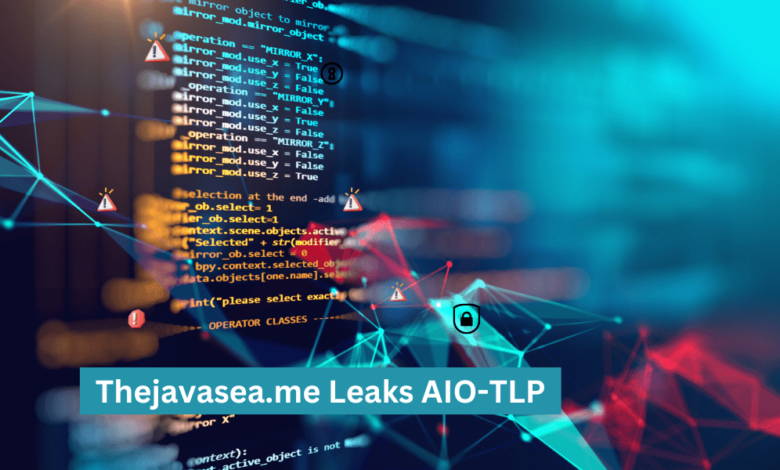thejavasea.me leaks aio-tlp: Everything You Need to Know About the Latest Data Breach

thejavasea.me leaks aio-tlp In the world of online platforms and data-sharing, security breaches are a growing concern. One recent event that has caught the attention of cybersecurity experts and users alike is the “thejavasea.me leaks aio-tlp.” These leaks have caused widespread alarm, exposing sensitive data and raising important questions about data security. In this article, we’ll dive into the details of the leak, the risks involved, and the necessary steps to protect yourself from such breaches.
What is thejavasea.me leaks aio-tlp and AIO-TLP?
Understanding thejavasea.me leaks aio-tlp
thejavasea.me leaks aio-tlp is a website that has gained some notoriety over time, primarily known for offering various tools, software, and data packages. Its users often download content ranging from applications to system tools, typically for free or through premium membership plans. However, the platform’s reputation has been marred by its association with data leaks, especially the notorious AIO-TLP leak. While the site itself may have legitimate uses, it has also attracted attention due to its lax security protocols, which have made it an easy target for cybercriminals.
Many users flock to thejavasea.me leaks aio-tlp for accessing software and tools that may not be readily available on mainstream platforms. However, such tools are often bundled with risks like malware, spyware, or even stolen data. This leaves users vulnerable to data breaches, identity theft, and other malicious activities. The presence of vulnerabilities in its system, combined with poor user data protection, contributed significantly to the AIO-TLP leak. This breach is not just a simple hack—it highlights a broader problem with how personal and sensitive data is handled on the web.
AIO-TLP: What Does It Mean?
AIO-TLP, or All-In-One Tool Leak Pack, refers to a type of malicious data bundle containing a variety of leaked tools, software, and often, sensitive information. These packages typically include user credentials, passwords, and even personal data that have been exposed during previous data breaches. In the case of thejavasea.me leaks aio-tlp leaks, AIO-TLP was a compilation of these stolen tools and information that were made available to unauthorized users, exacerbating the issue.
The AIO-TLP leak pack is especially dangerous because it aggregates a wide range of data and tools into a single downloadable package, making it even more enticing for hackers and malicious actors. The leak involves not only the theft of software but also the exposure of personal information such as login credentials, financial details, and private conversations. For individuals whose data was part of this leak, the consequences can be severe, ranging from identity theft to financial fraud.
Timeline of thejavasea.me leaks aio-tlp
Initial Discovery of the Leak
The discovery of thejavasea.me leaks aio-tlp’s AIO-TLP leak sent shockwaves through the cybersecurity community. The breach was first reported by a concerned user who noticed that a significant amount of personal information was being shared without consent on forums and dark web marketplaces. The leak’s discovery happened after a string of unusual activities on thejavasea.me leaks aio-tlp, including unexpected downtime and data inconsistencies. This raised suspicions that the platform had been compromised.
As more users began to report unauthorized access to their accounts and data, the scale of the breach became clearer. Cybersecurity experts quickly identified that the breach was linked to the AIO-TLP leak pack, which had been distributed to various online platforms. The leak was first traced back to an insecure database, where user information was stored without proper encryption or security measures. As the breach grew in size, it became clear that many individuals had unknowingly shared their personal data on the site, unaware of the risks involved.
Extent of the Breach
Once the full scale of the breach was realized, experts identified that the data exposed included email addresses, usernames, passwords, credit card details, and more. This kind of data exposure is highly concerning, as it allows cybercriminals to engage in identity theft, phishing, and other forms of fraud. Users who had stored sensitive personal information on thejavasea.me leaks aio-tlp unknowingly became targets for malicious activity. With tools and data such as these in the hands of hackers, the threat to affected users became even more pronounced.
Notably, the AIO-TLP leak didn’t just involve the exposure of personal information. The leak pack contained software tools that could be used for further malicious activities, such as hacking attempts, system infiltrations, and malware installations. This made the leak even more dangerous, as it gave attackers the ability to use the leaked tools to further compromise other systems.
Steps Taken by Authorities
In response to the growing concerns, law enforcement and cybersecurity organizations began investigating the breach. The authorities took immediate steps to assess the damage and trace the origin of the attack. A multi-agency task force was formed to track down the perpetrators responsible for the leak, though the individuals behind the breach remain unidentified as of now. The investigation also focused on preventing further distribution of the AIO-TLP leak pack to avoid additional damage.
During this time, thejavasea.me leaks aio-tlp issued a public statement acknowledging the breach and apologizing for the incident. They assured users that they were working with experts to improve their security protocols, though many users remained skeptical about the platform’s future. Law enforcement agencies, in collaboration with cybersecurity firms, launched a broader investigation to identify the source of the leak and prevent future data compromises.
The Impact of AIO-TLP Leaks
Security Risks
The security risks associated with the thejavasea.me leaks aio-tlp leak are vast and alarming. The exposed data, which includes user credentials and sensitive information, puts individuals at a high risk of identity theft, financial fraud, and cyberstalking. Hackers can easily exploit these vulnerabilities to steal money, impersonate victims, or access additional personal accounts. With tools included in the AIO-TLP pack, malicious actors can target even more systems, making it an escalating threat.
Furthermore, the leak increases the likelihood of phishing attacks, where criminals impersonate trusted entities (such as banks or email providers) to steal personal information. Since many individuals reuse passwords across different platforms, the exposure of a single password can lead to multiple compromised accounts. Once the attackers gain access to a user’s accounts, they can change passwords and lock out the owner, potentially causing long-term damage.
Impact on Users and the Industry
For the users affected by the breach, the fallout can be significant. Many of them are now faced with the challenge of securing their personal information and recovering from financial losses. Credit card fraud, unauthorized access to bank accounts, and identity theft are just a few of the dangers individuals face. For those whose data was exposed, the psychological toll can be just as severe, as trust in online platforms is often shaken by such incidents.
The impact on the wider cybersecurity industry is also notable. The breach highlights the need for more robust security practices, especially for platforms that handle sensitive user data. Companies are under increasing pressure to implement stronger encryption methods, user authentication systems, and breach detection tools to avoid similar incidents in the future. The breach serves as a stark reminder that even well-established websites are not immune to cyber threats.
Case Studies: Real-World Examples of Impact
Several high-profile cases of individuals affected by the thejavasea.me leaks aio-tlp have emerged. In one case, a user reported that their credit card details were used for unauthorized purchases shortly after their data was exposed. Another individual discovered that their email account had been hijacked and used to send phishing emails to their contacts. These cases highlight the real-world consequences of the leak and serve as cautionary tales for others.
For companies, the impact is also profound. Some businesses that had accounts on thejavasea.me leaks aio-tlp found themselves targeted by hackers, who used the exposed login credentials to launch additional attacks. These businesses now face the challenge of regaining control of their compromised systems and rebuilding their reputation after such a breach.
How to Protect Yourself from Leaked Data and Future Breaches
Immediate Actions for Affected Users
If you believe your data was part of the AIO-TLP leak, there are several immediate steps you should take to minimize the damage. The first and most crucial step is to change all passwords associated with your online accounts. This includes not only accounts on thejavasea.me leaks aio-tlp but also any other platform where you may have used the same or similar login credentials. Strong, unique passwords are essential to reducing the risk of further exposure.
Additionally, it’s vital to monitor your accounts for suspicious activity. This means regularly checking bank statements, credit card transactions, and email accounts for signs of unauthorized use. If you notice any discrepancies, report them to the relevant authorities immediately. Many financial institutions offer fraud detection services that can alert you to any unusual transactions.
Long-Term Cybersecurity Measures
While immediate actions are necessary, long-term strategies are essential to protect yourself from future breaches. One of the most effective ways to enhance your security is by using a password manager. These tools generate and store strong, unique passwords for each of your accounts, reducing the likelihood of password reuse and making it easier to manage multiple logins.
Two-factor authentication (2FA) is another critical measure. By enabling 2FA on your accounts, you add an extra layer of security, requiring both your password and a verification code (usually sent to your mobile device) to access your account. This significantly decreases the chances of unauthorized access.
For businesses and website owners, implementing encryption for stored user data is a fundamental step in safeguarding sensitive information. Regular security audits and updates can help prevent vulnerabilities that could be exploited in future attacks.
Tips for Website Owners
Website owners must take proactive steps to ensure the safety of their users’ data. This includes encrypting sensitive information, using secure protocols for data transmission (such as HTTPS), and regularly updating security software. It’s also crucial to educate users about best practices for online security, such as using strong passwords and recognizing phishing attempts.
Additionally, businesses should invest in breach detection tools that can alert them to unauthorized access or anomalies in real time. Being able to quickly identify and address security threats is key to preventing data loss and minimizing the damage caused by breaches.
Conclusion
thejavasea.me leaks aio-tlp has raised significant concerns about online data security. The breach exposed sensitive information, affecting countless users and highlighting vulnerabilities in how personal data is handled. By understanding the details of the breach, recognizing the risks involved, and taking appropriate action, users can better protect themselves from future incidents.
It is crucial for both individuals and organizations to prioritize cybersecurity and stay vigilant in an increasingly interconnected world. By following best practices for data security, we can reduce the chances of falling victim to data breaches and protect our online identities from malicious actors.



